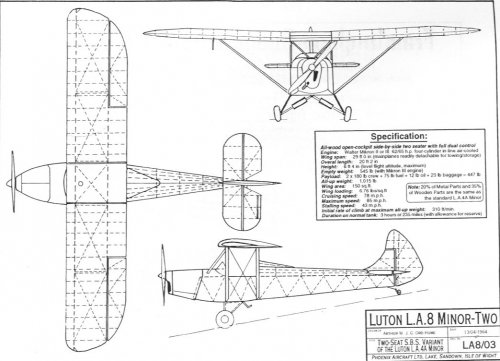The Luton L.A.3 Minor was a conventional parasol-wing, single-seat light aircraft designed by C.H. Latimer-Needham and flown in 1938 after after earlier experimentation with the L.A.2, a tandem-wing design inspired by the Mignet HM.14 Pou-du-Ciel (Flying Flea), and incorporating components from the previous prototype. The L.A.4 was a redesign of the L.A.3 specifically for amateur building and only one was built by the factory.
After the war Latimer-Needham and Arthur W.J.G. Ord-Hume redesigned the aircraft as the L.A.4A to suit slightly more powerful engines and it became one of the mainstay designs of the early Popular Flying Association (PFA, now LAA) in the UK. Ord-Hume, a well-know aviation writer among other careers, is still active (see http://ord-hume.net) and over the years has produced two significant variations of the Luton Minor, both as yet unbuilt:
The Minor 2000, per Ord-Hume in recent e-mail correspondence, is "a logical successor to the Minor LA.4A and apart from having the same specification, is even easier to build. One criticism [of the original Minor] was the amount of plywood in its construction. At the time it was first designed, aircraft plywood was extremely cheap and easy to obtain. It is now the opposite. The Minor's over-engineered structure used plywood as an expensive covering: today fabric's much better and the ply can be reduced with a consequent weight-saving."
A more substantial redesign is the L.A.8 Minor-Two, pictured below, which according to Ord-Hume, "exists as a wind-tunnel model and a partial set of drawing ands has never flown." Steve Slater's Luton Minor fan site (see http://www.kingpinmedia.co.uk/_OtherSites/LutonMinor/) has this to say about the Minor-Two, "The L.A.8 Minor-Two was a design exercise for a two seat Minor from the drawing board of Arthur Ord-Hume in 1964. It was originally known as the Commander. The design utilised many common parts from the La4 Minor, offered a 38 inch wide side by side cockpit, and today would probably be powered by the 80 hp Jabiru engine (the original design specified a Walter Mikron IIIAE 65hp engine). Like the new Minor 2000 design, the trailing edge centre section, as well as space behind the seats, incorporated stowage space (a feature rather lacking in the original Minor).
According to Ord-Hume, plans for the Minor 2000 and the L.A.4A are complete but are in the process of being redrawn due to deterioration of the originals. He also offers plans for the Luton L.A.5 Major (a wood-and-fabric Cub-like enclosed cabin, tandem-seat design). He no longer offers plans for his redesign of the Gardan GY.20 Minicab, rights to which were sold to Mike Shave in Canada (see http://gy20minicab.blogspot.com/). Ord-Hume also makes it a point to distance himself from the Knowles Duet, a one-off two-seat variation of the Luton Minor of which he is not a fan.
After the war Latimer-Needham and Arthur W.J.G. Ord-Hume redesigned the aircraft as the L.A.4A to suit slightly more powerful engines and it became one of the mainstay designs of the early Popular Flying Association (PFA, now LAA) in the UK. Ord-Hume, a well-know aviation writer among other careers, is still active (see http://ord-hume.net) and over the years has produced two significant variations of the Luton Minor, both as yet unbuilt:
The Minor 2000, per Ord-Hume in recent e-mail correspondence, is "a logical successor to the Minor LA.4A and apart from having the same specification, is even easier to build. One criticism [of the original Minor] was the amount of plywood in its construction. At the time it was first designed, aircraft plywood was extremely cheap and easy to obtain. It is now the opposite. The Minor's over-engineered structure used plywood as an expensive covering: today fabric's much better and the ply can be reduced with a consequent weight-saving."
A more substantial redesign is the L.A.8 Minor-Two, pictured below, which according to Ord-Hume, "exists as a wind-tunnel model and a partial set of drawing ands has never flown." Steve Slater's Luton Minor fan site (see http://www.kingpinmedia.co.uk/_OtherSites/LutonMinor/) has this to say about the Minor-Two, "The L.A.8 Minor-Two was a design exercise for a two seat Minor from the drawing board of Arthur Ord-Hume in 1964. It was originally known as the Commander. The design utilised many common parts from the La4 Minor, offered a 38 inch wide side by side cockpit, and today would probably be powered by the 80 hp Jabiru engine (the original design specified a Walter Mikron IIIAE 65hp engine). Like the new Minor 2000 design, the trailing edge centre section, as well as space behind the seats, incorporated stowage space (a feature rather lacking in the original Minor).
According to Ord-Hume, plans for the Minor 2000 and the L.A.4A are complete but are in the process of being redrawn due to deterioration of the originals. He also offers plans for the Luton L.A.5 Major (a wood-and-fabric Cub-like enclosed cabin, tandem-seat design). He no longer offers plans for his redesign of the Gardan GY.20 Minicab, rights to which were sold to Mike Shave in Canada (see http://gy20minicab.blogspot.com/). Ord-Hume also makes it a point to distance himself from the Knowles Duet, a one-off two-seat variation of the Luton Minor of which he is not a fan.

